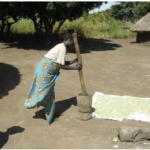


Kenya Agricultural and Livestock Research Organization,
Amhara Regional Agricultural Research Institute, National Semi-Arid Resources Research Institute, Kote Mtaani Health and Environment Concerns (KOMHEC), Kenya Agricultural Commodity Exchange (KACE), Kenya Industrial Research and Development Institute (KIRDI), NaSARRI, Cooperating Agricultural Research Centers (RCs)
Ethiopia, Kenya, and Uganda
11/2010—11/2014
Finger millet (FM; Eleucine coracana) is an important crop grown by resource poor farmers in eastern and southern Africa for subsistence, culture, and income. Its nutritive properties and excellent storability make it ideal for management of malnutrition among children and adults; diet for diabetics, HIV/AIDS patients, and invalids; and food security. It can also withstand various environmental challenges better than maize. Despite its advantages, FM has received little attention in terms of research and development. Major constraints have hampered production and utilization of FM to 15% of its output potential, including limited improved varieties, poor crop management practices, pests and diseases, poor soil fertility, limited commercial utilization and lack of an organized marketing system for FM and its products.The present study expands on a previously McKnight funded Chlorodoid project (2006), and aims at contributing to increased FM production, food and nutrition security, and farmers’ income to improve livelihoods. This will be achieved through breeding of varieties that are high yielding, resistant to blast disease and drought; development of agronomic technologies that focus on optimal spacing, use of organic and inorganic fertilizers (including the “green manure” Desmodium); pest and weed control; development of farmer friendly production and processing equipment; technology dissemination; strengthening of the FM seed system and enhancing human and institutional capacity in FM research, and production and utilization in the EAf region. The project will be conducted in all the three EAf countries: Kenya, Ethiopia and Uganda.
Development of environmentally sustainable and gender considerate technologies to increase production, utilization, and trade in finger millet.Up- and out-scale working technologies and approaches to improve productivity and production of finger millet in finger millet producing areas.Development of new and better FM varieties that will resist blast disease, lodging and drought and that will provide higher yields under farmer conditions.Enhance the human and institutional capacity, networking and linkage of stakeholders in finger millet production in the Eastern Africa region.
In Uganda new varieties have been advanced to pre-release stage. In Ethiopia, new varieties Necho, Baruda, and Dibatse were released. Baruda is resistant to Striga.In Kenya 12 genotypes showing resistance to blast, 12 genotypes with no or minimal support for Striga, four showing drought tolerance and 22 showing no lodging were identified, with one variety recommended for release by Kenya Plant Health Inspectorate Services (KEPHIS). There were six accessions highly resistant to blast identified in Uganda and two locally collected accessions, ‘Omuga’ and ‘Kali with five drought tolerant lines identified. Finger millet transplanting was compared with broadcasting, with grain yield and tiller number significantly higher under transplanting. Grain yield increased with a decrease in planting density. The 30 cm row spacing and 10 cm space between hills gave the highest yield of 3064.7 kg/ha for finger millet transplanting.To address finger millet threshing constraints, single drum and dual drum threshing mechanisms were tested. Both threshers reduce threshing time and grains loss, however the dual drum thresher preformed better.A total of nine on-farm demonstrations were established in the districts of Kaberamaido and Ngora, representing various soil fertilities. Liquid fertilizer (NPK) locally referred to as Synergizer was applied in split application at rate of 25kg/ha (third of recommended 75 kg/ha). Application of fertilizer increased plant heights and also increased grain yields. Improved varieties gave higher yields than the local variety both when fertilizer was applied and not applied. Higher yields were obtained Anyara sub-county. This means that application of fertilizer at micro-doze level (1/3 of the recommended doze) had significant effect on finger millet grain yields in both locations, but highest in sites with low soil fertility.During the first rainy season of 2014, five hundred (500) farmers from Kyere sub-county Serere district received 5 kg of seed each the varieties SEREMI 2, for multiplication under the farmer – to – farmer seed loan scheme.10 demonstration fields aimed at exposing to farmers and other users to the available improved finger millet technologies were set up in Kumi, Kaberamaido, Lira, Apac, Gulu, Serere, Kyere, Bugondo and Manafwa districts during April 2014. Released varieties were included in the demonstration fields. Promotional materials for farmer use in the form of variety descriptors (400), posters (3) and calendars (50) were prepared in order to catalyse the promotion and dissemination of the technologies. Farmers generally preferred early maturing varieties with big heads and strong straw. A farmer group thanked KARI and summed up the benefits they had reaped from the project in a statement “KARI has moved us from darkness to light since we had concentrated on maize and sugarcane and forgotten about finger millet”.
